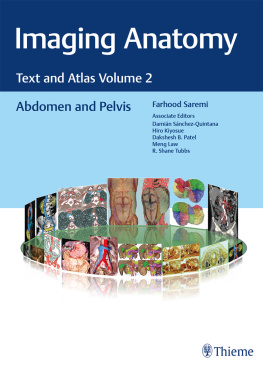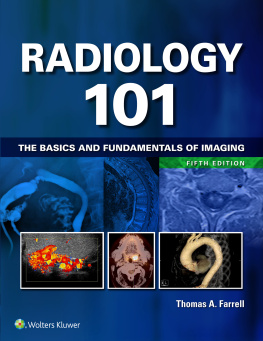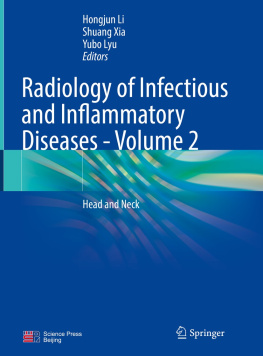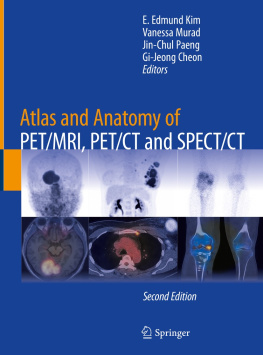Morton A. Meyers , Chusilp Charnsangavej and Michael Oliphant Meyers' Dynamic Radiology of the Abdomen Normal and Pathologic Anatomy 10.1007/978-1-4419-5939-3_1 Springer Science+Business Media, LLC 2010
1. A New Paradigm
Science is characterized by discoveries. While the discovery of new facts is reportable, facts alone do not constitute the entirety of science. Facts are the enemy of truth! cried Don Quixote de la Mancha. Certainly, unprocessed facts, facts taken at face value, may limit our grasp of fundamental relationships. Understanding comes from making connections between many disparate facts. Such pattern recognition need not require immense data sets. In his insightful The Art of Scientific Investigation , W.I.B. Beveridge declares: More discoveries have arisen from intense observations of a very limited material than from statistics applied to large groups, for only by being familiar with the usual can we notice something as being unusual or unexplained. This is especially true in the biological sciences, where progress is achieved not only by new information but also by the improved understanding of puzzling phenomena, the removal of contradictions, the making of better predictions, and the determination of connections between previously unconnected phenomena. Essential is the development of new concepts often integrating the new with the previously established facts.
A paradigm is a universal adoption of scientific achievements that for a period of time provides the model for problem solving. One can become so invested into the prevailing paradigm that revolutionary advances making their appearance are categorically denied. Nothing illustrates this more dramatically than the utterances of false prophets.
Hear the prediction of Yale Professor Irving Fisher just before the 1929 stock market crash. Fisher declared that stocks had reached what looks like a permanently high plateau. As we all know, the plateau abruptly turned into an abyss.
Economics is accepted for its dubious accuracy, but science is regarded as, well, scientific. But despite stunning breakthroughs in medicine over the past century, false prophets have long trumpeted the end of scientific advances. Consider these
X-rays will prove to be a hoax.
Lord Kelvin, English physicist and President of the Royal Society, 1896
Everything that can be invented has been invented.
Charles H. Duell, commissioner of the U.S. Patent Office, in a letter to President William McKinley, urging him to close the office, 1899
We can surely never hope to see the craft of surgery made much more perfect than it is today. We are at the end of a chapter.
Berkeley George Moynihan, Leeds University Medical School, 1930
The great era of scientific discovery is over. Further research may yield no more great revelations or revolutions, but only incremental, diminishing returns.
John Horgan, science journalist, 1996
Reality shows that such statements border on farce.
A shift in paradigm occurs after new discoveries, new facts, new problems concerning the facts cannot be explained within the existing framework. This shift comes only after a reevaluation of traditional procedures indicates the inadequacy of underlying concepts leading to an altering of perception and the introduction of a new paradigm. It is the initiation of inquiry into the reigning paradigm that is the most difficult part in the transformation process. The difficulty lies in recognizing that a problem exists and in noting precisely the point or points to direct the inquiry.
In many fields most notably in physics advances during the twentieth century have been made by discarding mechanistic principles of what came to be known as the scientific method and adopting a new concept. The world could no longer be viewed and understood as a multitude of individual objects but rather as one indivisible dynamic whole, whose parts are interrelated and understood as integrated parts of the whole.
The fields of biology and psychology have also raised serious questions about the scientific method. Inductive reasoning comes into question with views on perception according to the reporting individual and actual objects. Experiences are subjective with the brain formulating the images we perceive. The processes of perception themselves are unconscious and involve a whole range of presuppositions. How we grasp an image is very much dependent upon multiple factors: our presuppositions, expectations, experiences. This has been demonstrated by psychologists by a series of drawings with subtle progressive differences until the last panel depicts an illustration radically different from the first (Fig. ). The recognizable point of transition where the image shifts in the viewers perception is different depending whether the viewer traces the series from left to right or backward. This illustrates that pre-conditioning in other words, the concepts of expectation, prior knowledge, and experience determines in large measure visual perception.
Fig. 11.
A drawing of a mans face subtly changes to the outline of a young female.
The transition point is dependent not only on subjective variations but also on the sequence followed.
In abdominal radiology, the traditional concept divides the abdomen and pelvis into component parts. This proved useful in the broad classification of disease processes, but with the technological developments and widespread applications of axial imaging the traditional concepts failed to explain all observations.
Axial imaging provides the exciting capability to visualize portions of the abdomen and pelvis not imaged previously. It has become apparent that the traditional analysis of compartmentalization does not fully explain certain manifestations of the spread of disease. Significantly, spread between intraperitoneal organs, spread between intraperitoneal and extraperitoneal sites, spread within the extraperitoneal compartments, and spread within areas not previously described, e.g., root of mesenteries, all demanded a new paradigm. Our perception of images of the abdomen needs a new abstraction and a new conceptual model to provide the fullest understanding of the spread and localization of disease processes.
There is always a reluctance to change paradigms, especially one that has served us for years. However, inquiry toward a new solution starts when something is unsatisfactory and traditional methods provide an inadequate solution. The critical step is to realize the problem and initiate inquiry.









